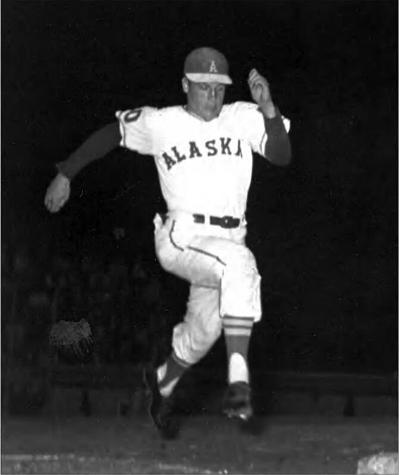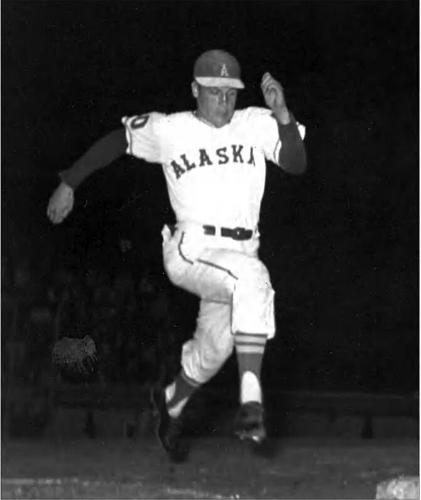The summer of 1964 was a memorable one for the Fairbanks Goldpanners baseball team. That was the summer that a young hurler by the name of Tom Seaver arrived to play for the Panners. His introduction to Fairbanks baseball was memorable to say the least.
Fairbanks Daily News-Miner
May 16, 1966
Tom Seaver Has
Good Pro Start
After Controversy
and Confusion
Excerpt from larger article
Coming to Fairbanks after the season had started (he had put in his summer duty as a Marine Reserve) he lost no time getting into action. After arriving on an afternoon flight, he was taken to the Boucher Apartment for a uniform and then to the ballpark. He entered the park just in time to be given a ball and was then sent to the bullpen to warm up — having time to meet only the player who was to warm him up.
The Panners got deeper in trouble and Seaver was waved into the mound — and this was when he met, for the first time, his catcher and infield teammates. After putting out the fire, Seaver walked to the Panner dugout where he was to finally meet the rest of the Panners.
Seaver’s two seasons with the Panners were both short ones in Fairbanks due to Marine Reserve obligations though he was able to be with the team for both tournaments at Wichita.
In 1964 Seaver made the All-American team selected at the tournament. He appeared in five games, winning two without a loss. This was the season the Panners used two or more pitchers per game, using relief hurlers even when the starter was not in trouble. One of Seaver’s games was a no-hitter he shared with Mike Paul. In 1965 he pitched in two games, winning one and losing one.
In each year, Seaver chalked up the most tournament innings of any of the Panner pitchers and ended up with a 2.25 earned run average in 1964, and a 1.19 average last year—a combined two-year average of 1.57.”
•••
Fairbanks Daily News-Miner
Jun 3, 1967
Former Goldpanner Now Golden Boy
of Mets
“One more like him and we’ll be
on our way.”
Manager Wes Westrum, who has been suffering in silence since he took over the New York Mets for banker Casey Stengel two years ago, was talking about Tom Seaver, a young pitcher who may put the mythical Frank Merriwell to shame.
Westrum knows a great deal about pitchers because he caught the best while breaking eight fingers for the New York Giants.
Seaver is a former Alaska Goldpanner of Fairbanks. He played for the Panners in 1964, where he built up an impressive pitching record and a 2-0 tally for the NBC tournament in Wichita, Kan.
“At 22 Seaver is one of the most advanced pitchers I have ever seen,” Westrum began, drooling over a cup of coffee. “He reminds me of Robin Roberts when he was winning 20 games a year because he is so consistent.
“Tom challenges the hitters, fields his position well, covers first base, hits the ball and knows how to run the bases. He is what you might call the complete ball player. Even when the Mets are at bat, he’s in the ball game on every pitch.
An Inspiring Athlete
“He is the kind of a great athlete who inspires, and I hope some of it rubs off on the other young players we have. When he beat the Dodgers for his second complete game in succession on May 22, I made him my No. 1 pitcher. I plane to use him every fifth day.”
•••
Fairbanks Daily News-Miner
Oct. 1, 1976
From Craig Smith’s column
Who’s the most famous Goldpanner of all time? It has to be Tom Seaver.
Yet when Seaver joined the club in 1964 he wasn’t a blue-chip prospect. Instead, he was an add-on and putting him in a Panner uniform was more a goodwill gesture than a sound baseball decision.
The Panner general manager at the time was “Red” Boucher who was responsible for creating the Goldpanner organization. In June he got a call from USC baseball coach Ron Deadeax asking him to take a young pitcher named Seaver from Fresno City College because Seaver was headed for USC.
Since Deadeux was a prime source of Goldpanner talent and had already helped the Panners sign four players that year, Boucher agreed to take Seaver.
“We always took one of two players that were ‘maybes’ as far as Rod was concerned,” Boucher said in a recent interview.
“I called Tom in Fresno, and he indicated that he wanted to finish his Marine Corps commitment by going to summer camp first. I was real impressed by that and said fine. But I said, ‘Take a ball and glove with you to camp and be ready to throw when you get up here.”
The day Seaver arrived in Fairbanks he was met at the airport with a Goldpanner uniform for him to put on immediately. The Panners were playing Bellingham as the plane landed and the starting pitcher’s curve ball was hanging in the air and getting whacked all over Growden Field.
When Seaver got to the ballpark, he started to walk toward Boucher to say hello. Boucher didn’t have time for niceties.
“I pointed to the bullpen and said, ‘Go warm up.”
Seaver entered the game and went on to win it.
Seaver lived with the Bouchers both seasons he was here and worked in Boucher’s sporting goods store.
“I guess the biggest thing I was impressed with in Tom, was that emotionally he knew what he wanted in life. He wasn’t that serious. He kidded a lot and was well-liked by the ball players, but as a person he really had it together.
Seaver was the third best pitcher on the Panner staff that first season. Boucher said there were other pitchers who could throw as hard as Seaver but said everything Seaver threw “moved” and that Seaver “knew how to throw to batters.”
That didn’t prevent Seaver from getting bombed at times. In a game at Grand Junction, Colo. the altitude seemed to take something off his pitches and Grand Junction was having a field day.
Boucher recalls that Seaver and the entire team had been acting cocky and silly and playing poorly on the road trip. In the sixth inning of this particular game the Goldpanners were down about 12 runs, when Boucher went out to the mound. He recalls sharply telling Seaver, “I don’t care if you stay out here all night and embarrass yourself. There’s not going to be anyone relieving you.” The Panners Lost.
Going into Wichita for the national tournament a few days later, a friend in the Cincinnati Reds organization told Boucher he could get Ken Holtzman to play for the Panners. The addition of Holtzman, though, would mean dropping Seaver since the roster was limited to 16 players.
“I got Tom up to the hotel room and had a talk with him. He was really determined. In fact, he was upset when I said he might not be part of the tournament squad. I decided to go with Seaver and forget Holtzman.”
It was a wise decision.
In the national tournament the Panners go in a tough game with Bob Moore’s Oldsmobile of Wichita and the Panners trailed.
Seaver was brought in as a relief pitcher with the top Wichita slugger at the plate, Boucher went out to talk to Seaver but recalls Seaver looking at him straight in the eye and saying, “If you haven’t taught me enough by now, you’ve wasted your time so give me the ball and get the hell out of here.”
The first pitch came in on the batter’s chin and he dove for the dirt. The next pitch was a fastball near the fists. The third pitch was a hit for an easy grounder and the hitter was thrown out.
In the bottom of the eighth inning the Panners had the bases loaded and Seaver was the next scheduled hitter.
“Normally you pinchhit your pitcher,” Boucher said. “Tom wasn’t a bad hitter, but he was no slugger. I was looking over the dugout and about to call for a pinchhitter when he grabs and (the) bat and looks at me with a look that says, ‘If you pinchhit for me, I’ll…..”
Seaver stepped to the plate, then proceeded to hit one of the longest homers in Panner history. Seaver said it was one of his biggest thrills in baseball.
The Panners won the game but later were eliminated in the tournament.
After the season Boucher helped Seaver get a full scholarship to USC.
Seaver returned to the Panners midway in the 1965 season after another Marine summer camp. By then he was a definite rising star.
Seaver invited Boucher to be his guest at the 1969 World Series. Boucher didn’t go. He was too nervous. He watched Seaver pitch the Mets to the world championship on television.











